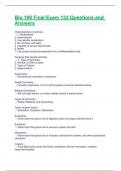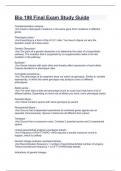Bio 198 - Study guides, Class notes & Summaries
Looking for the best study guides, study notes and summaries about Bio 198? On this page you'll find 123 study documents about Bio 198.
Page 3 out of 123 results
Sort by
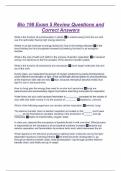
-
Bio 198 Exam 5 Review Questions and Correct Answers
- Exam (elaborations) • 13 pages • 2024
-
Available in package deal
-
- $9.49
- + learn more
What is the function of a photosystem in plants to collect energy from the sun and use it to split water freeing high energy electrons Where in an atp molecule is energy stored and how is the energy released in the bond holding the third phosphate released by breaking the bond in an exergonic reaction What is the role of nadh and fadh2 in the process of aerobic respiration to transport energy rich electrons to the first acceptor of the electron transfer system What is the function of endocyto...
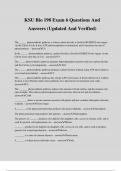
-
KSU Bio 198 Exam 6 Questions And Answers (Updated And Verified)
- Exam (elaborations) • 11 pages • 2024
- Available in package deal
-
- $11.49
- + learn more
KSU Bio 198 Exam 6 Questions And Answers (Updated And Verified) The ______ photosynthetic pathway is where carbon dioxide is fixed by RUBISCO into sugars via the Calvin Cycle. It uses ATP, photorespiration is minimized, and it increases the rate of photosynthesis. - answerC4 In the ______ photosynthetic pathway, carbon dioxide is fixed by RUBISCO into sugars via the Calvin Cycle (just like in C4). - answerC3 The _____ photosynthetic pathway separates light-dependent reactions and uses car...
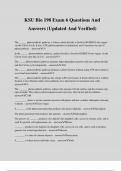
-
KSU Bio 198 Exam 6 Questions And Answers (Updated And Verified)
- Exam (elaborations) • 11 pages • 2024
- Available in package deal
-
- $12.49
- + learn more
KSU Bio 198 Exam 6 Questions And Answers (Updated And Verified) The ______ photosynthetic pathway is where carbon dioxide is fixed by RUBISCO into sugars via the Calvin Cycle. It uses ATP, photorespiration is minimized, and it increases the rate of photosynthesis. - answerC4 In the ______ photosynthetic pathway, carbon dioxide is fixed by RUBISCO into sugars via the Calvin Cycle (just like in C4). - answerC3 The _____ photosynthetic pathway separates light-dependent reactions and uses car...
Bio 198 Final Exam 133 Questions and Answers.
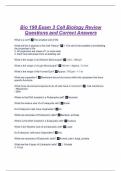
-
KSU Bio 198 Exam 6 Practice Questions and Correct Answers
- Exam (elaborations) • 12 pages • 2024
-
Available in package deal
-
- $9.49
- + learn more
C4 The ______ photosynthetic pathway is where carbon dioxide is fixed by RUBISCO into sugars via the Calvin Cycle. It uses ATP, photorespiration is minimized, and it increases the rate of photosynthesis. C3 In the ______ photosynthetic pathway, carbon dioxide is fixed by RUBISCO into sugars via the Calvin Cycle (just like in C4). CAM The _____ photosynthetic pathway separates light-dependent reactions and uses carbon dioxide and the Calvin cycle temporarily. C3 The ______ photosynthetic pathw...
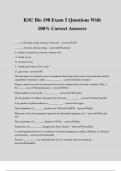
-
KSU Bio 198 Exam 5 Questions With 100% Correct Answers
- Exam (elaborations) • 9 pages • 2024
- Available in package deal
-
- $11.49
- + learn more
KSU Bio 198 Exam 5 Questions With 100% Correct Answers _____ is the main energy currency of the cell. - answerATP _______ reactions release energy. - answerExergonic A cell that is placed in an isotonic solution will: A. shrink in size B. increase in size C. neither gain water or lose water D. gain water - answerC The movement of molecules across a membrane that requires the useof carrier molecules and the expenditure of energy is called ______________. - answeractive transport Energy...
Bio 198 Final Exam Study Guide
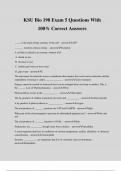
-
KSU Bio 198 Exam 5 Questions With 100% Correct Answers
- Exam (elaborations) • 9 pages • 2024
- Available in package deal
-
- $11.49
- + learn more
KSU Bio 198 Exam 5 Questions With 100% Correct Answers _____ is the main energy currency of the cell. - answerATP _______ reactions release energy. - answerExergonic A cell that is placed in an isotonic solution will: A. shrink in size B. increase in size C. neither gain water or lose water D. gain water - answerC The movement of molecules across a membrane that requires the useof carrier molecules and the expenditure of energy is called ______________. - answeractive transport Energy...
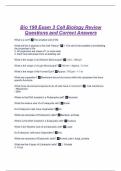
-
Bio 198 Exam 3 Cell Biology Review Questions and Correct Answers
- Exam (elaborations) • 11 pages • 2024
-
Available in package deal
-
- $9.99
- + learn more
What is a cell? The smallest unit of life What are the 3 aspects of the Cell Theory? 1. The cell is the smallest unit exhibiting the properties of life 2. All organisms are made of 1 or more cells 3. Each new cell arises from an existing cell What is the range of an Electron Microscope? 1 nm - 100 μm What is the range of a Light Microscope? 100 nm - Approx. 1.5 mm What is the range of the Human Eye? Approx. 110 μm - < 1 m What are organelles? Membrane-bound structures within the cytopl...
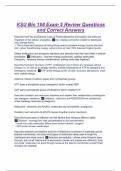
-
KSU Bio 198 Exam 5 Review Questions and Correct Answers
- Exam (elaborations) • 10 pages • 2024
-
Available in package deal
-
- $8.99
- + learn more
Describe the First and Second Laws of Thermodynamics and explain why they are important to the cellular energetics. 1st - energy cannot be created or destroyed, only change forms. • This is important because all living things need a constant energy source (the sun) 2nd - when transforming energy, some is lost as heat (10% between trophic levels) Define endergonic and exergonic reactions and describe how they are linked in cellular energetics. Endergonic - requires energy (hydrolysis; splittin...

That summary you just bought made someone very happy. Also get paid weekly? Sell your study resources on Stuvia! Discover all about earning on Stuvia

